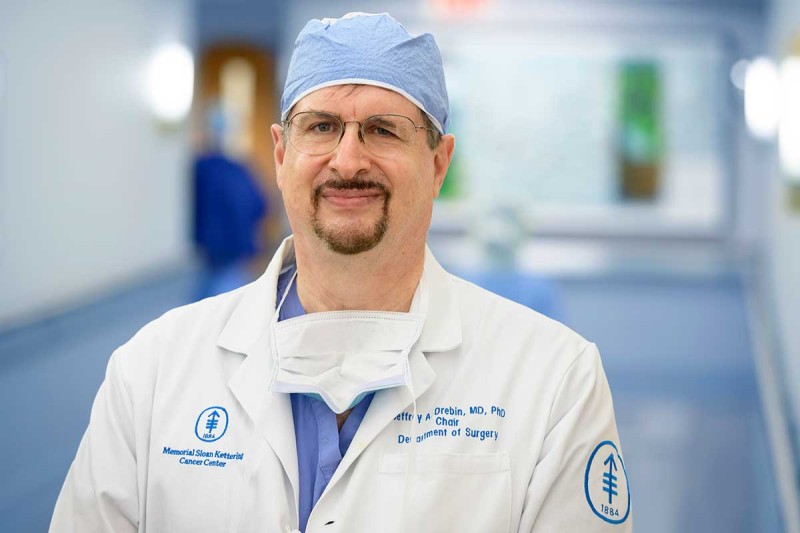
Jeffrey Drebin, Chair of the Department of Surgery, is among the MSK experts highly skilled at diagnosing and treating pancreatic cysts.
Surgery for pancreatic cysts is complex. MSK has among the most experienced pancreatic surgery teams in the country. Our surgeons do more than 350 pancreatic operations each year.
This volume is among the highest in New York City, and across North America as well. Patients at hospitals that do a higher number of pancreatic surgeries have better treatment results. MSK developed methods that make pancreatic surgery safer for more people.
Surgery is the best treatment for some pancreatic cysts. The surgery methods we use to remove pancreatic cysts are the same as for pancreatic cancer. Most pancreatic cysts are benign (not cancer), but some are precancerous and can turn into pancreatic cancer.
We may recommend open surgery, laparoscopic surgery, or robot-assisted surgery. With all of these methods, the goal is to remove the cysts while keeping your digestive system working well. It will still turn food into nutrients and get rid of waste.
Surgery methods for pancreatic cysts
Our team will recommend a surgery method that’s best for you. MSK surgeons are experts in these pancreatic cyst surgeries:
Whipple procedure
The Whipple procedure is the most common surgery for pancreatic cysts. It’s also called a pancreatoduodenectomy (PAN-kree-uh-toh-DOO-ah-deh-NEK-toh-mee).
This surgery removes the head of the pancreas and the gall bladder. It also removes the duodenum (first part of the small intestine), and the end of the common bile duct. Sometimes part of the stomach is removed. Your surgeon will reconnect the tissues.
MSK offers 2 types of Whipple surgery:
Traditional open Whipple. Our team does many more open Whipples than other hospital in the country. The Whipple procedure is a very complex operation. Research shows hospitals that do a high number of these surgeries have fewer complications and better results.
Robotic Whipple: MSK is one of the few cancer centers to offer Robotic Whipples. This procedure is minimally invasive.
People who have this surgery:
- Spend less time spent in surgery and in the hospital.
- Have better quality of life after the surgery.
- Have less pain and smaller scars from surgery.
The robotic Whipple is a newer treatment for pancreatic cysts. It may not be right for everyone. Your MSK care team will talk with you about which surgery method is best for you.
Read about Chris, who had pancreatic cancer, to learn more about MSK’s Robotic Whipple program.
Distal pancreatectomy
A distal pancreatectomy (PAN-kree-uh-TEK-toh-mee) is surgery to remove a cyst from the body or tail of the pancreas. It’s usually done when the cysts are only in the tail of the pancreas. This surgery removes the tail, and sometimes part of the body of the pancreas. We often also must remove the spleen (splenectomy).
Total pancreatectomy
A total pancreatectomy is surgery to remove all of the pancreas if the cyst has affected many parts of it.
Because of the location, your surgeon also must remove other organs. This includes the gallbladder, and part of the stomach and the duodenum (the first part of the small intestine). They also remove the lower half of the bile duct, the spleen, and nearby lymph nodes.
Your surgeon will reconnect your stomach and the rest of your common bile duct to your jejunum (the second part of your small intestine). This lets food and bile flow into your small intestines.
After this surgery, you will need to take insulin and pancreatic enzymes for the rest of your life.
Minimally invasive surgery for pancreatic cysts
We can do some pancreatic cyst surgeries using methods that are minimally invasive. This kind of surgery does less harm to your body because it’s done with small incisions (cuts). Laparoscopic and robot-assisted surgeries are minimally invasive.
Laparoscopic surgery
In laparoscopic surgery, your surgeon will make a small incision on your abdomen (belly). They will put a laparoscope through the incision. The laparoscope is a long, thin surgical tool with a video camera. It lets your surgeon see inside your body.
Your surgeon may also put long, skinny surgical tools into other small cuts on your abdomen. They can use the tools to remove pancreatic cysts, and all or part of the gland. They may also rebuild the digestive system during this procedure.
With a laparoscopic surgery, your surgeon directly controls the surgical tools with their hands. They can see the images from the laparoscope on a monitor.
Robot-assisted laparoscopic surgery
With a robotic-assisted surgery, your surgeon uses the da Vinci® Surgical System. They sit at a console and control a robot that moves the surgical tools. There are hand, finger, and foot controls. The console has a special monitor where they can see the images from the laparoscope in 3D.
MSK’s operating rooms have the latest technology, including 9 robotic platforms.
Benefits of minimally invasive pancreatic cyst surgery
Minimally invasive surgery is an option that’s better for some people than regular surgery. Benefits include:
- Loss of less blood.
- A shorter hospital stay.
- A faster recovery.
Request an Appointment
Available Monday through Friday, to (Eastern time)


